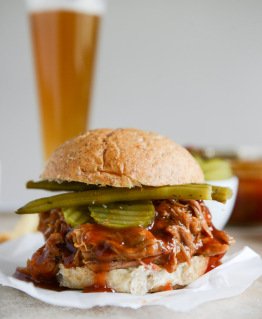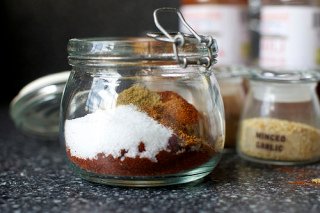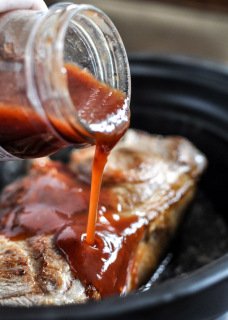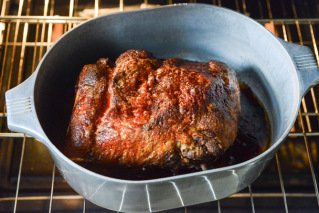Slow-roasted "the best damn pulled pork of your life" with homemade KC barbeque sauce
Okay so listen up. This may be a little long.
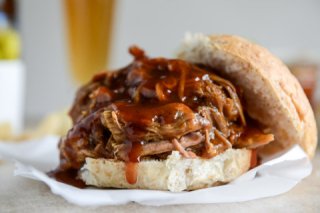
You don't know me that well yet, but as we get acquainted, you'll come to realize that my preoccupation about food and recipes is acute to the point of indicating some real psychological issues. It's sort of progressed past the "hobby" stage and entered "bona fide obsession" territory. That is okay with me! The whole point of keeping a recipe journal (which I've done, methodically, since 2012) is to over time reduce the trial and error process in the kitchen. I love experimenting, but I don't want to have to be trying something new every time I make dinner, you know? So part of what I do is obsess until I have found The Perfect Recipe. I research, cross-reference, combine recipes and techniques, basically whatever I need to do to put together a recipe that needs no forethough (aside from arranging your mise en place), no tweaking, and no stress. It really streamlines things.
Not every recipe in my collection falls into the repeat-tested category. I'm thinking of maybe adding a Tested And Approved section or something. I'm happy to have put together at least several that I'm really proud of...the recent German chocolate cake I posted in my intro post, my brown butter vanilla bean cookies, my peanut satay sauce, those really tasty chipotle sweet potatoes...etc. (Stay tuned folks!)
This, my friends, is the newest addition to the category. And I'm particularly pleased with it because it's a really big deal. Barbeque holds a hallowed station in American cuisine and has legions of devotees. People guard their sauce and dry rub recipes with their life. Fistfights have been started over barbeque. But here I can offer you a truly foolproof pulled pork recipe, from start to finish, that can be done in the oven (no smoker necessary, although it would be nice if I had one). With this versatile and tasty weapon, you will never be without a reliable means of seduction - for while there will always be a time and a place for haute cuisine, nothing truly elicits a human's primal lustful impulses quite like an enormous hunk of juicy shredded meat.
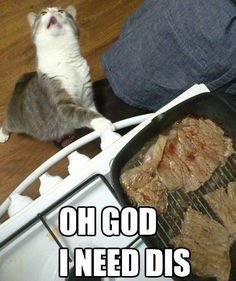
Anthropologically accurate depiction
To be fair, I couldn't really claim this to be the BBQ To End All BBQ, because there are literally hundreds of different styles and permutations of barbeque, and a lot of it is down to personal taste. So here, I went with what I think is probably the most well-known and familiar version, started with a dry rub which sits on the meat for at least two hours, and a Kansas City-style sweet, ketchup and brown sugar-based sauce. Both the rub and the sauce make a lot, so this may seem a little time-consuming at first, but you can store them both for a fairly long time (the sauce will be good in the fridge for at least a couple months, and the spice rub will last basically indefinitely). As a sidenote, a little jar of the rub and a Mason jar of the sauce would make a cute little gift for someone or many someones.
Because I will not take tips from just anyone, this recipe is from a real, genuine expert. I won't say who it is, but he is a very well-known blogger, pitmaster and food critic who seriously knows his stuff.
With all that in mind...let's make meat magic!
For the dry rub:
Ingredients
- 3/4 cup firmly packed dark brown sugar
- 3/4 cup white sugar
- 1/2 cup paprika
- 1/4 cup garlic powder
- 2 tablespoons ground black pepper
- 2 tablespoons ground ginger powder
- 2 tablespoons onion powder
- 2 teaspoons rosemary powder
- 1/4 to 1/2 teaspoon salt per pound of meat
Preparation
Mix all the ingredients except for the salt. Regular rosemary won't really work here, so either buy crushed or powdered rosemary or run some fresh or dried stuff through a spice mill or food processor.
For the barbeque sauce:
Ingredients
- 2 tablespoons chili powder
- 1 teaspoon ground black pepper
- 1 teaspoon table salt
- 2 cups ketchup
- 1/2 cup yellow ballpark-style mustard
- 1/4 cup cider vinegar
- 1/3 cup Worcestershire sauce
- 1/4 cup lemon juice
- 1/4 cup steak sauce
- 1/4 cup dark molasses
- 1/4 to 3/4 cup honey, to taste
- 1/2 to 1 teaspoon hot sauce
- 1 cup dark brown sugar
- 1 teaspoon liquid smoke
- 3 tablespoons vegetable oil
- 1 medium onion, finely chopped
- 4 medium cloves of garlic, crushed or minced
Preparation
While the roast is doing its thing (see below), make the sauce. This recipe makes about one Mason jar's worth, when it's simmered down properly, and it goes well with all sorts of different meats, especially grilled chicken. This is a brown sugar, ketchup-based sauce that seems to be one of the more popular sauces (in contrast with the vinegary sauces from the Carolinas, which tend to be too sour for me). The longest thing by far is getting all the ingredients together - once it's on the stove simmering, you can pretty much leave it alone until it's done.
(A note about hot sauce: this is where you can really let your individual preferences run wild. While regular Tabasco will certainly work, I actually used a much-hotter-than-Tabasco hot sauce that one of my chili-head friends made for us. It's got a wonderful, deep smokyness which comes from the charred peppers. I chose this one to add, along with the liquid smoke, a realistic smoke flavor even if you're cooking this indoors. Just make sure to adjust the proportions accordingly - our friend's hot sauce was basically twice as strong, so I just used 1/2 teaspoon. YMMV.)
In a small bowl, mix the chili powder, black pepper, and salt. In a large bowl, mix the ketchup, mustard, vinegar, Worcestershire, lemon juice, steak sauce, molasses, honey, hot sauce, and brown sugar. Mix them, but you don't have to mix thoroughly.
Over medium heat, warm the oil in a large saucepan. Add the onions and sauté until limp and translucent, about 5 minutes. Crush the garlic, add it, and cook for another minute. Add the dry spices and stir for about 2 minutes to extract their oil-soluble flavors. Add the wet ingredients. Simmer over medium heat for 15 minutes with the lid off to thicken it a bit. It will lose its overly tangy flavor as the vinegar slowly cooks off.
Then taste and adjust. Add more of anything that you want a little bit at a time - it may taste a bit vinegary at first, but that will be less obvious when you use it on meat. If you'd like the texture to be smoother (which I do), strain it so the onion and garlic stay out...you still get their flavor without the lumps.
To prepare the meat for roasting:
Generally the cut people choose for pulled pork is called a butt or a shoulder. You can ask your butcher if you're unsure of exactly what you're looking for. Generally I would say that a small roast (feeding 3-4 people) would run around 2.5 lbs, a medium roast (feeding 5-6 people) around 4-5 lbs, and a large picnic roast around 6 lbs. If you are looking for a smaller roast but only see larger cuts, just take it over to the butcher and he'll cut it down to whatever size you like.
Ideally, you'll salt and season your cut of meat the day before - this produces the best crust, which is most people's favorite part of the whole thing. If you have time, sprinkle on 1/4 to 1/2 teaspoon of table salt per pound of meat up to 12 hours in advance. Then slather it in a thin layer of oil - this will help the salt penetrate the meat.
Now apply the dry rub generously, working it into the meat. To prevent contaminating your rub with uncooked meat juices, spoon out the proper amount before you start and seal the bottle for future use. Keep your powder dry. To prevent cross-contamination, one hand applies the seasoning and the other hand does the rubbing. Don't put the hand that is rubbing into the powder. The longer you refrigerate your seasoned meat, the better the crust will be, so do this as far in advance as possible (no less than 2 hours).
Preheat your oven to about 250F. I know this sounds super low, but you're going to be roasting this thing for a looooong time, at minimum a good 4 hours. Everyone has their different theories on cooking temps, but really you just have to eyeball it. Some people like to jack the oven up to around 300F for the last hour or so - just keep checking it. The main indicator of doneness will be a meat thermometer, which is basically a necessity for this recipe...you won't really be able to tell if it's finished just from looking at it, and it's very, very important your meat is cooked all the way through. Meat thermometers run from a couple bucks to instant-read ones over $100. You just stick it in the thickest part of the roast and wait for it to register at least 175F (if it reads less than that, put it back in), and ideally around 190F.
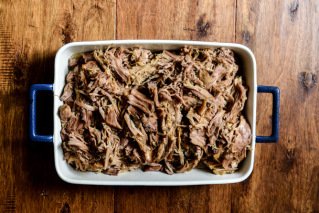
Once you take the pork out of the oven, let it rest for 10-15 minutes, then shred with two forks (or your fingers, if you wait for it to cool). Serve on potato rolls with pickles and the barbeque sauce on the side to let your guests add their own - less is more!
Then sit back, eat, and congratulate yourself: for you have just made the best damn pulled pork of your life.
